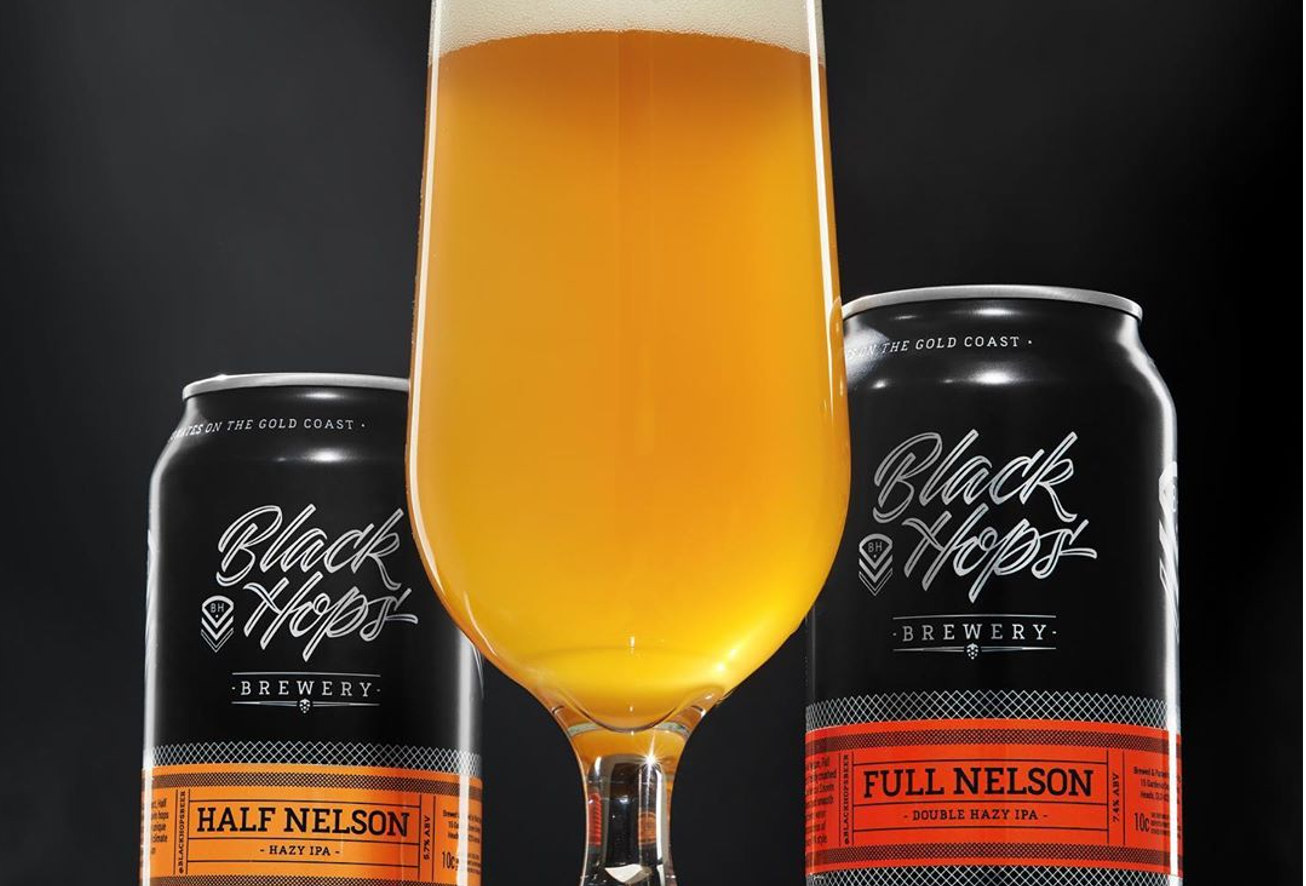Just like Sour beers, Hazy beers are all the rage right now in Aussie craft beer circles. We talked about Sours and how we brew them on the blog not so long ago. So now it’s time to delve into the juiced up, murky world of Hazy IPA’s.
It’s also good timing after we recently added long time cult fan fave, G.O.A.T. Hazy IPA, to our Core Range of beers.
The Origins of Juicy, Hazy Beers: Hello NEIPAs!
The origins of Hazy beers can be traced back to a relatively recent sub-class of IPA’s known as NEIPA’s – or New England IPAs. The name refers to their place of origin, in the New England region in the North East of the USA (specifically in the state of Vermont).
This style of American IPA is defined by its so-called ‘juicy’ aroma and flavour. As their name suggests, these beers can have a cloudy hue which gives them a ‘hazy’ appearance, as opposed to the clear, sparkling finish of beers such as Pale Ales and Lagers.
It’s signature ‘haziness’ is mainly the result of the style of yeast used, with the addition of high protein malts and being heavily dry hopped during the brewing process. Overall these beers are fuller and less bitter than regular IPA’s. In terms of mouthfeel, it’s smoother and creamier than other IPA’s.
It originated in 2004 in the form of an IPA known as the Heady Topper, which was brewed by The Alchemist Brewery. It’s murky, orange-like appearance and fruity flavour and aroma came about as a result of not filtering or pasteurizing the beer during the brewing process, creating a beer rich with microscopic cultures, enzymes and compounds.
NEIPA’s began to appear in US craft beer circles around 2011, exploding onto the beer landscape four years later and launching what became known as ‘the haze craze’.
When the Black Hops founders headed over to the U.S. on their first trip in 2018 it was abundantly clear that Hazy’s had become a massive part of the scene over there. In Portland in particular, there were some venues with 6-8 different hazy beers on tap. At the time they were rare in Australia, and were only introduced into the official style guidelines for the AIBA beer awards later that year.
Shake Hands With Milk: the ever expanding world of Hazy Beers
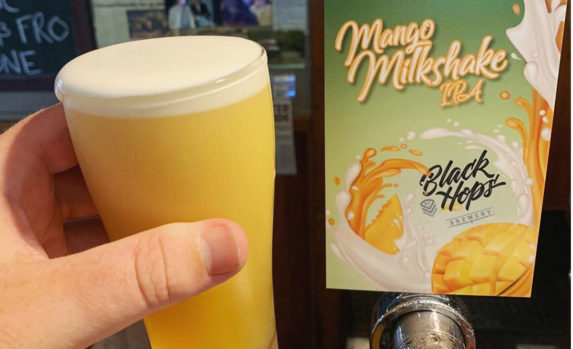
Since the rise of NEIPA’s and the advent of the haze craze, a number of different Hazy sub genres, such as Hazy Pale Ales, have become more and more popular.
And then there’s the offshoot or sub-genre of Hazy’s known as Milkshake IPA’s – there’s even Smoothie and Slushie IPA’s out there now! Initially dismissed by many as a fad, these beers use lactose and fruity additions to give them their signature creamy, juicy, full bodied texture, as well as unfermentable sugars and adjuncts such as vanilla.
So far at Black Hops we’ve mainly focussed on brewing Hazy IPA’s, with a smattering of Double/Imperial and Milkshake IPA’s. We’ve actually shied away from brewing strictly defined NEIPAs, mainly because there is a perception that they have to look, smell and taste a particular way. Their style origins are actually quite diverse, but rather than challenge the underlying perception we’ve chosen to focus on Hazy IPAs, as the parameters of acceptance around them are a bit more broad ranging.
You can find the full rundown of all of the Hazy beers we’ve brewed further below..
Juicy vs Hazy vs Cloudy
The words ‘hazy’ and ‘juicy’ often get lumped together when it comes to describing Hazy IPA’s. The term ‘juicy’ goes hand in hand with the word ‘fruity’, which is a descriptor used in brewing to denote the flavour and aroma of certain hops as well as the esters created by yeasts. Esters are a fruity flavour produced during fermentation and are formed during the brewing process by the esterification of ethanol. Most hazy beers are described as having fruity or juicy flavour characteristics.
The origins of the term ‘hazy’ actually go way back in brewing circles, when it was used to describe the presence of unwanted proteins hanging in suspension in a beer. These days though it refers to beers that often display a cloudy hue or hoppy shimmer.
But this is where things get a bit tricky. Because while a cloudy appearance is often a feature or by-product of hazy beers, describing them as cloudy or murky can be cause for confusion. Cloudy and murky beers such as German Hefeweizens are nothing like the smooth fruit bombs of typical Hazy IPAs. So in terms of terminology, it’s probably best to keep the words ‘cloudy’ and ‘murky’ separate from the word ‘hazy’.
The Science Of Making Beer Hazy And How We Brew Them At Black Hops
Hazy beers get their hazy characteristics through a few specific brewing factors, namely in relation to:
- water chemistry
- yeast strains
- the type of grains used
- the type of hops and when it is added
- avoiding filtering and pasteurizing
Chemistry
We use a high chloride:sulphate ratio which is the opposite approach to a typical hoppy pale beer but due to the extremely high hopping rates, we are actually trying to accentuate the smooth malt body and not the hops, as they speak for themselves.
Yeast
We use many different ale strains, usually the more fruity, ester-driven English styles. There are many new craft yeast labs propagating new hazy/juicy yeast strains specifically for these styles of beers. We have been using them also for a while now and have even started planning a program to capture our own local wild strains to isolate and use.
Hops
Fruitier styles of hops are used and are heavily dry hopped and added late in the boil during the brewing process.
We favor hops that fall into the tropical fruit spectrum with a bit of dankness and pine. Citra, Mosaic, Amarillo, Columbus and Riwaka are regulars for us but there are new experimental varieties coming out each year that we love playing with. The likes of Sabro and Strata have been standouts for 2020.
When we add the hops late in the boil (whirlpool), we lower our temperature to between 85-90°C to limit the amount of bitter oil isomerisation and retain as much of the hop flavour compounds as possible.
Grains
High protein grains such as rolled oats and wheat are typically used to get the protein levels up and help form the desired haze.
No Filtering and Pasteurizing
Filtering is counter-intuitive when it comes to Hazies, so we don’t do it when brewing them.
Pasteurization is also a difficult process to include when brewing such highly hopped beers that focus on fresh flavours and aromas, but there are some modern methods to allow for these beers to be pasteurized to improve shelf life. In saying that, it’s not an approach that we take.
Hazy Beers We’ve Brewed So Far
Ever since we got with the haze craze and brewed our very first Hazy, Beetlejuice, in 2017, we’ve been steadily building our Hazy resume. Here’s what we’ve come up with so far (listed in alphabetical order).
Beetlejuice (Black Hazy IPA)
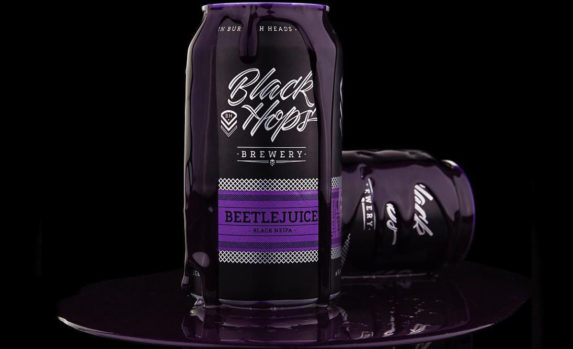
Originally brewed in collaboration with The Scratch Bar in Milton for The Weekend of Darkness 2017, this unique 6% Black Hazy IPA, which we christened Beetlejuice, was our twisted, dark take on the current haze craze.
Caribbean Crusher / Caribbean Haze (Single / Double Hazy IPA’s)

We always love doing a fun beer for GABS, and after the success of our Caribbean Crusher single Hazy IPA, we thought it was worth a crack at a double version.
Caribbean Haze was brewed in collaboration with Mount Gay Rum for the 2019 GABS. This Caribbean-inspired hazy Double American IPA was spiced with citrus, pineapple, mango and coconut-infused Mt Gay Black Barrel Rum, to give this already aromatic style a fresh Caribbean twist.
It went down so well that we ended up brewing it twice to make sure we could get a fresh version out in cans after GABS.
Citra Hazy IPA
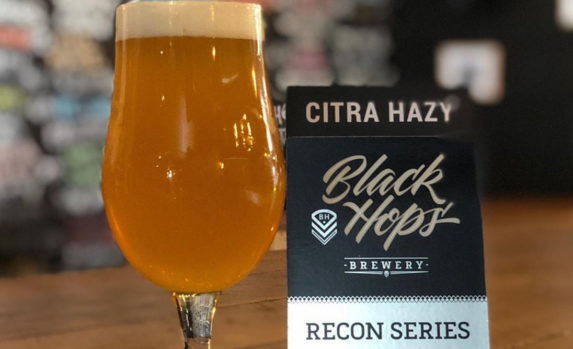
As part of our Recon Series single hop focused hazy project, Citra Hazy, as the name suggests, was a celebration of Citra, one of the most coveted high-impact aroma hops coming out of the U.S. It boasted a complex lineage including Hallertau, Tettnanger and East Kent Goldings that delivered a strong citrusy profile of grapefruit and lime.
G.O.A.T. (Hazy IPA)

G.O.A.T. was first brewed as a small batch beer, specifically for the 2018 AIBA Awards (where the ‘hazy’ category was introduced for the first time). We brewed it with high expectations and named it accordingly, and the beer delivered, taking out a Gold Medal and becoming a favourite among Black Hops drinkers. And in May 2020 we officially added it to our Core Range of beers.
This juice bomb features the signature opaque appearance of the style, paired with an explosion of tropical fruit flavours thanks to the generous late addition of Mosaic, Amarillo and El Dorado hops.
Half / Full Nelson (Hazy IPA’s)
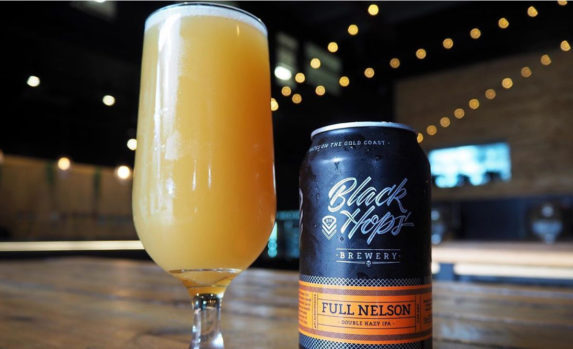
The crowd favourites from our single hop-focused hazy project, our Half and Full Nelson Hazy IPAs exploded with fruity characters of freshly crushed gooseberries and passionfruit, unique to Nelson Sauvin hops. A bittersweet balance of hop flavour and smooth malt mouthfeel was achieved through clever water chemistry adjustments and the incorporation of protein-rich malts, signature to the Hazy IPA style. This mixed haze-craze came out blazing with the 5.7% Half Nelson, followed by the 7.4% Full Nelson counter attack!
Malt, Honey And Chocolate Milkshake IPA
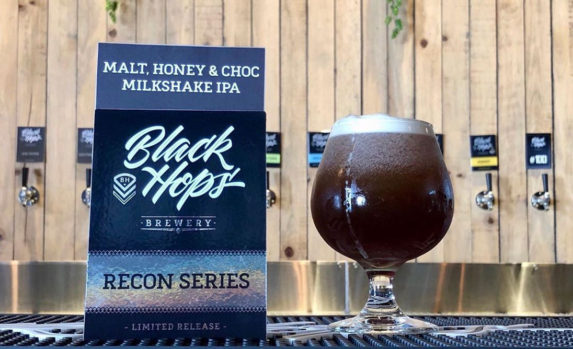
Drawing inspiration from our neighbours at BHII, Norco, and their classic flavoured milk of the same name, we came up with this Malt, Honey and Chocolate Milkshake, poured on nitro, for our our Taproom IPA Day celebrations last year.
Mango Milkshake IPA

Pouring on nitro and bringing together tropical hops, sweet malts, juicy mango and smooth vanilla, our Mango Milkshake IPA delivered a full-bodied texture and bold opacity that’s akin to what you’d slurp on at a malt shop.
Pink Boots Double Hazy IPA
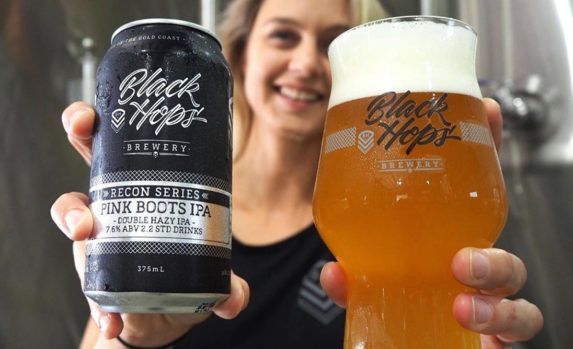
Brewed in collaboration with the Australian chapter of the Pink Boots Society, we brewed a Double Hazy IPA showcasing the 2020 Pink Boots Hop Blend. This hop blend was chosen by more than 100 PBS members during the 2019 Great American Beer Festival. The blend consists of Azacca, El Dorado, Idaho Gem and Loral, creating a blend with tropical, citrus and piney aromatic qualities.
Sour Hazy IPA

Hop-heads and pucker-faces united when we brought together our love of hops, sour and haze in our Recon Series tanks. We brewed a delightfully soft kettle sour base, and dry hopped it daily for 5 consecutive days, each day with a new hop – Idaho 7, Amarillo, Mosaic, Citra and Cascade.
The A Team Hazy IPA
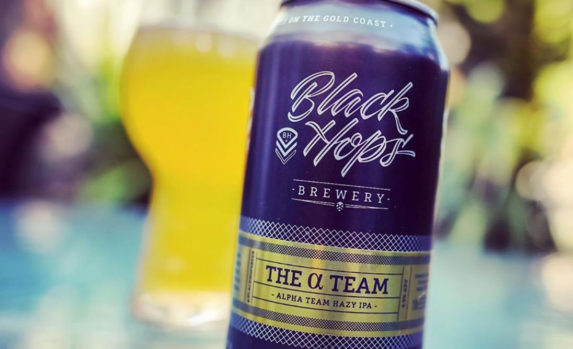
This beer, which was decided on and brewed by The Alpha Team of Black Hops investors, is a 6.8% hazy IPA loaded with fresh A hops, Amarillo, Super Alpha, Azaca, Ahtanum and Admiral.
Thunder Cloud Hazy IPA
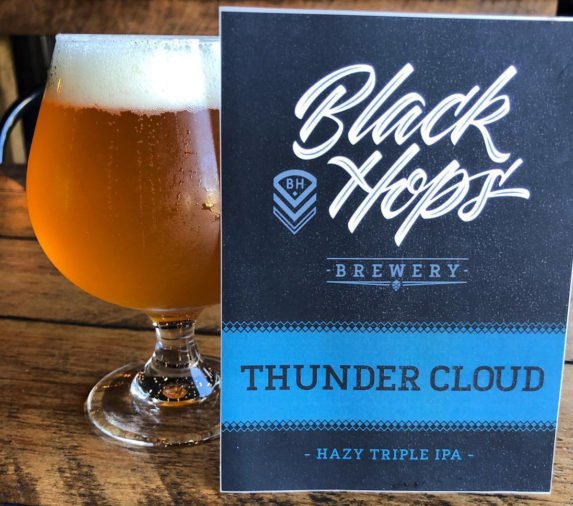
This was first brewed in Australia in January 2017 at our Burleigh HQ with our O.G. assistant-brewer Spencer Cloud, using a recipe that has been honed over many years with his father in their San Diego home brewery. A big tropical tribute to the West Coast IPA’s of past and present, this beer was all about balance.
21 Grams Per Litre Double Hazy IPA
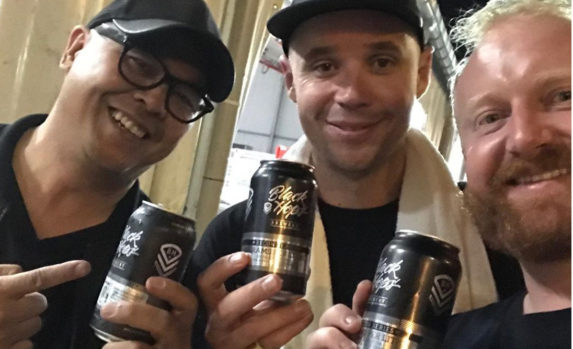
A Beer InCider 2019 Experience inspired by killer hip hop crew Thundamentals, 21 Grams Per Litre was a celebration of beer and music coming together as one soulful experience. This beer exploded with tropical, citrus and pine hop aromas and was grounded by a balancing blend of subtle pale malt character.
Hazy Horizons: GAB’s Revival And Cream Cloud
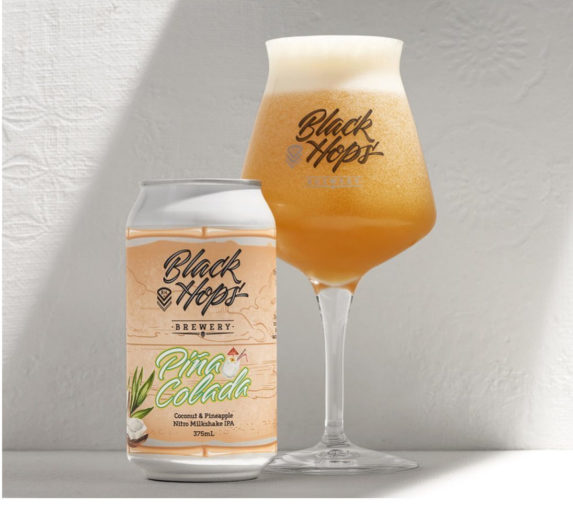
If Milkshake IPA’s are your thing, we’re just dropped our latest GABs offering for 2020, a 6.7% Pineapple and Coconut Nitro Milkshake IPA known as Pina Colada.
We’ve also re-brewed all five of our other previous GAB’s Beers for our upcoming GABs Revival 2020 Online Event. And we’re releasing all of our GABs beers in the form of a very limited, mixed six pack.
To celebrate the beers we’ll be holding a live call via our Facebook Ambassadors Group on Friday 5 June from 6pm. There’ll be a live tasting and a Black Hops People’s Choice segment. To opt into the Facebook Event, go here.
And coming soon, we have a 10% TDH Hazy IPA brewed with Oat Milk, which we’ve named Cream Cloud.
We hope you enjoyed the post, if you would like to ask us any questions about our Hazy beers, or have a suggestion for our next Hazy recipe, feel free to jump into our free Facebook Ambassadors Group.
